WATERCOLOR SCHOOL || The materials in watercolor: the colors - Los materiales en la acuarela: los colores


Hello everyone. After a long summer hiatus, I'm back with the watercolor tutorials. This time, I start with a series of articles about materials, which I will alternate with more exercises. Some of the images I have taken from my own materials, in my studio, and others belong to the websites of the different manufacturers. Let's start, then, with the colors.
Watercolor is a painting technique especially valued for its transparency, luminosity and cleanliness. It is also characterized by its immediacy and its gestural character, since movement and ease when applying the paint is fundamental. It is a technique that tends to synthesize the forms of the pictorial work, so the viewer ends up participating in the creative process when observing the work.
Watercolor colors, like those of any other technique, are composed of very finely ground pigments of various origins, a binder, gum arabic, which binds the pigment to the support, and glycerin, ox gall or honey, which are used as softeners that keep the gum arabic flexible, and prevent the dense layers of paint from cracking. A small amount of phenol is also added, which acts as a preservative and keeps the paint fresh longer. The medium or vehicle to deposit the color on the support with the application of the brush is water.
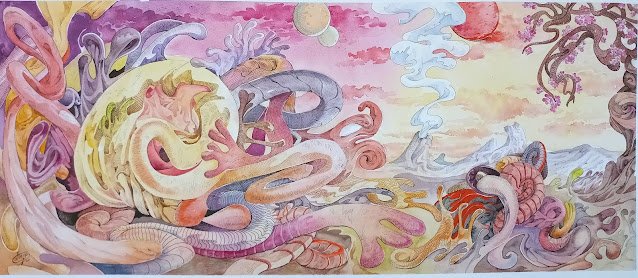
El planeta rojo, acuarela propia
Apart from the watercolors focused on the school environment, cheap and of low quality, the watercolors that we find in the market usually come in three forms: in tubes, in small pans of moist watercolor and in jars of liquid watercolor.
Watercolors in tubes and watercolor pans
Undoubtedly, these are the two most commonly types of watercolor used by amateurs and professionals.
The metallic tubes contain the paint in a creamy state, more or less thick, and this allows the painter to distribute the colors in the palette as he likes and in the quantity he sees fit. The capacity of the tubes usually varies between 5 ml and 15 ml, although there are houses that dispense larger tubes, such as Lukas, with its 24 ml tubes, Winsor&Newton and D'Avinci, with 37 ml tubes, and Holbein, which has 60 ml tubes. As paint dries on the palette over time, it is best to soften the colors before reusing them, either with a drop of water or by dampening them with a spray bottle.
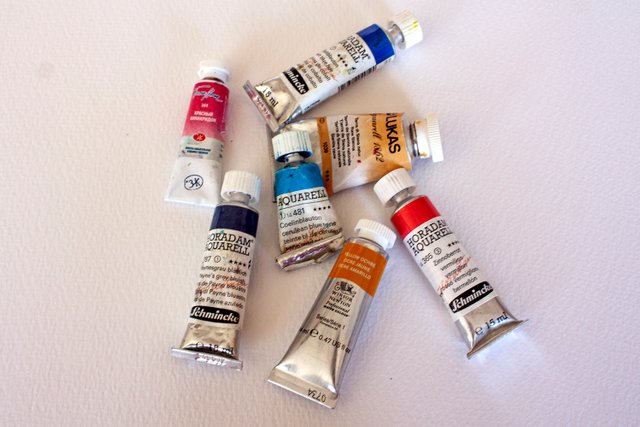
A bunch of tubes from my studio
Pans are solid tablets of pressed pigment, easy to dilute with a little water. They come in square white plastic boxes, and can be purchased individually in three sizes: standard, half-pan and double-pan. For convenience, they are usually sold in metal boxes, in assortments of 6, 8, 12 and 24 colors. Some boxes even include a tube of China white. Loose pans are, in fact, purchased to replace those that wear out in these boxes.
Once opened, the boxes also serve as palettes, as they leave all the colors in view. The back of the lid or a flap can even be used as a space for mixing, and many of them have a metal ring on the back to insert the thumb.
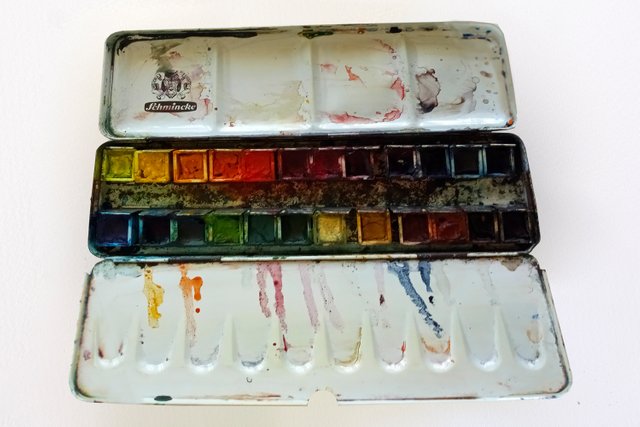
The box of pans that I currently use
The advantage of the tubes is that, with a simple pressure, you can extract the desired amount of paint, so you can dilute a good amount of color to make large washes. In addition, they take longer to dry than watercolor in pans. It is also easier to make mixtures with them. However, this ease of drawing the paint and mixing watercolors can work against us, as we can end up wasting a lot of paint if we do not calculate carefully.

Lukas 24 ml watercolor tubes
With the watercolor tablets, we have the whole range of colors at sight, we do not have to choose which colors to put in the palette, and the box itself is used for mixing. However, the size of the pans also conditions the size of the brush, and that does not make them suitable for large washes. In addition, as the arrangement of the tablets are very close to each other, we must be very careful not to contaminate and dirty the colors with the brush.

The ring of the pans box where the finger is inserted to use it as a paddle, once opened
Liquid watercolors, watercolor sticks and other watercolor products.
Liquid watercolor colors are very similar to inks, and are often used in the area of illustration. They are also the type of watercolor indicated for use with the airbrush, to give glazes, for example. They are presented in glass jars and are very fluid paints, with powerful and bright colors because very strong dyes are added to the pigments.
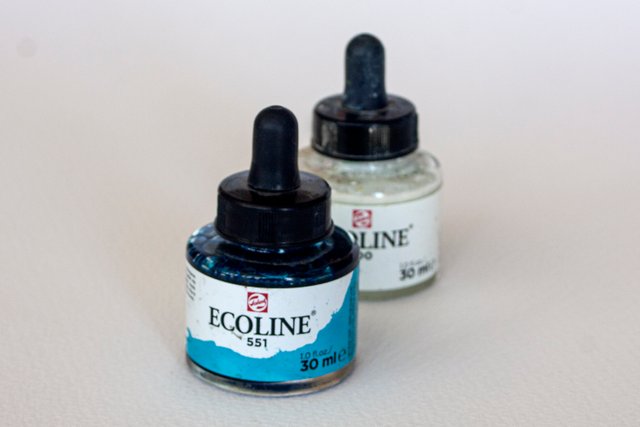
Liquid watercolor jars
Less known and less used, in general, are watercolor sticks, similar to pastel sticks. It is a type of watercolor that can be used both, dry (where water is the medium), and wet, either painting on a soaked paper, or using the sticks as if they were pans, extracting the paint with a brush.
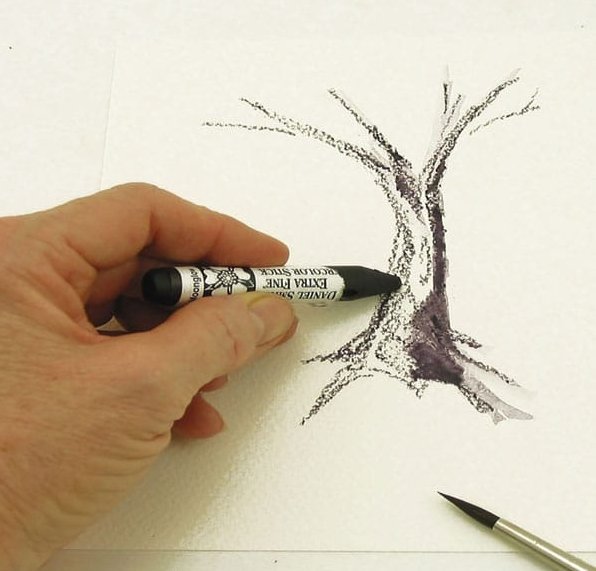
Watercolor stick, from Daniel Smith's web site
Finally, we can include in this section another type of materials used mainly by illustrators and graphic designers. These are watercolor markers and watercolor pencils. Both have the advantage of cleanliness and ease of use, and are also very convenient to carry. They are an alternative to paint with watercolor without carrying a lot of accessories. In the field of painting, they are mainly used to make details or superimpositions.
Watercolor markers could actually be considered painting instruments loaded with liquid watercolor, which apply colors through their porous tip. Most of them usually come with two tips, one thin and rigid and the other wider and more flexible. They are very colorful markers, and can be used by wetting the paper or by diluting the strokes with water on a palette. Watercolor pens are similar to traditional pencils, except that, in this case, they have water-soluble leads. They could almost be classified as a variant of the sticks. So they can be used dry, like traditional pencils, or drawn wet to achieve effects and blends.
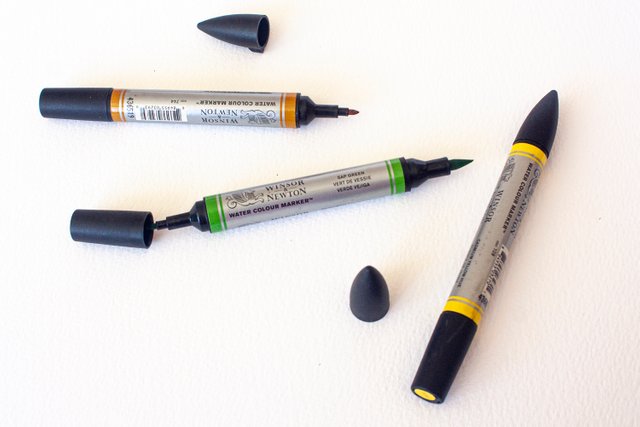
Winsor&Newton watercolor markers
Brands and qualities
In watercolor, the quality of the paint has a great influence on the final result. Much more than in other pictorial techniques. The transparency, the flexibility of the brushstroke or the mixtures depend, to a large extent, on the quality of the colors used. Hence the high price of brand-name watercolors. It is true that there are cheap watercolors, but their tones are far from the colorfulness and brilliance of the others, besides, it is difficult to remove the color from the tablets, the mixtures become dirty... I would not recommend them even for learning; I only see them as useful for children to develop their plastic imagination.
I personally have used for many years the French brand Paillard and, when it ceased to be marketed, I switched to Horadam Aquarell, from the German company Schmincke. I have, however, tubes and sets of different brands, either because they have specific colors or shades that interest me, or because they have different opacities, or because of the greater capacity of their tubes, as happens to me with those of Aquarelle 1862, by Lukas.
Other brands worthy of note for their quality are Renbrandt, from the Dutch company Royal Talens, Classic Watercolour, from Old Holland, also Dutch, and L'aquarelle, from the French company Sennelier. Among the British brands, the best are Winsor & Newton's Professional range and Daler Rowney's Artists' line. Equally notable are the Mission Gold brand, from the Korean company Mijello, and the Extra Fine range, from the American company Daniel-Smith. In Spain, Titan Arts Acuarela, from Titan, stands out.
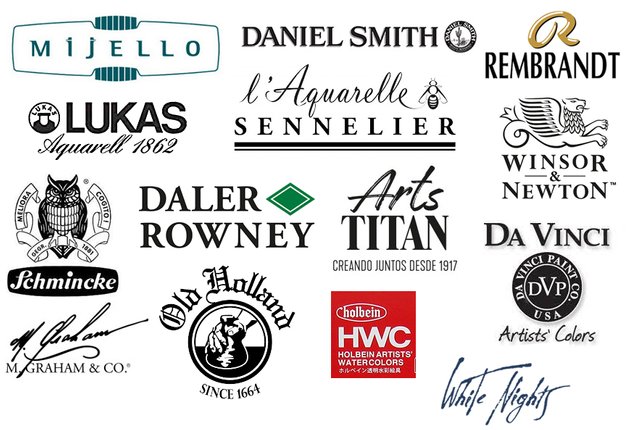
Main brands and manufacturers
There are other manufacturers that stand out for the quality of their watercolors, such as the American D'Avinci and M. Graham, the Italian Maimeri, and the Japanese Holbein, although I have not been able to test their products.
Then we have brands that, although they do not reach the extra quality of the previous ones, stand out for their price-quality ratio, so they are quite recommendable for art students, beginners in watercolor who have a limited budget, or for use in sketchbooks, or for quick travel sketches, for example. Of this type we have the Akademie Aquarell line by Schmikcke, Cotman by Winsor&Newton, Van Gogh by Royal Talens, White Nights by Russian San Petesburg, Aquafine by Daler Rowney and Aquarel Studio by Lukas.

I also use paints from this range
As far as liquid watercolors are concerned, we can highlight those of Vallejo and Ecoline, a brand of Royal Talens.
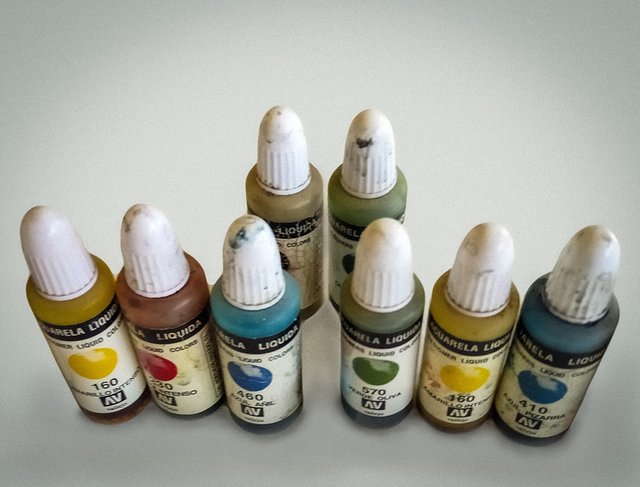
Some of my Vallejo liquid watercolors
Ecoline is also an outstanding brand of watercolor markers, and even has harmonic ranges of colors. The British Winsor & Newton also has quality markers for sale in boxes of 6 and 12 colors that work very well for me.

Ecoline range of markers for urban landscape, from the Royal Talens website
Range of colors
Each watercolor brand has its specific color chart, so each watercolorist can choose the assortment of colors they need. The color charts are huge but our palette can be formed with very few colors. Specifically, it would be well served with cobalt blue, cerulean blue, lemon yellow, yellow ochre, raw sienna, burnt sienna, crimson, cadmiun red, payne gray, emerald green, sepia and black. These are the colors I usually use. Sometimes I also use indigo blue, prussian blue, vermilion and cadmium yellow middle.
With the above colors you have a palette extensive enough to paint any subject. Nowadays, there are brands that have created exotic color ranges, with metallic sheens and other variants, but which are not necessary in the usual watercolor painting.
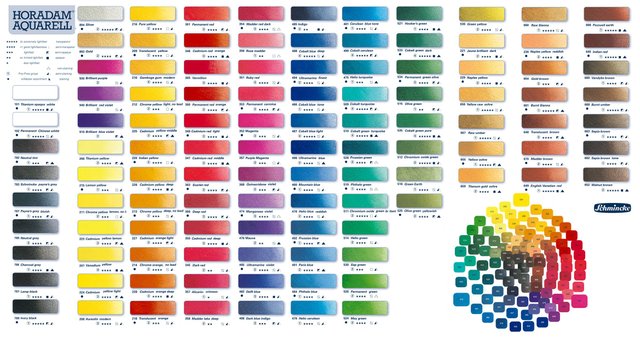
Horadam watercolors color chart
In any case, regardless of the brand, there are a number of colors to be very careful with, and a certain amount of experience is necessary to handle them well. For this reason, I directly recommend beginners to avoid them. Chrome yellow, for example, decolores quite easily, is not permanent, so it can alter the coloration of the work over time.
There is also emerald green, which cannot be mixed with cadmium yellows, so great care must be taken when using it. Also difficult are mixtures between ultramarine blue and chrome yellow or between cobalt violets and ochres. This is from the point of view of chemical stability.
Among the reds, we have vermilion which, apart from darkening with light, presents difficulties in mixing with many colors; it is best to substitute it with cadmium red. Crimson also discolors and makes it very difficult to obtain homogeneous mixtures with any color, although in watercolor this is of little importance.
Indigo blue is not permanent under strong light and ultramarine blue blackens under artificial light. Cinnabar green, hooker green, sap green and olive green are not very permanent.

Example of the arrangement of colors in the palette I usually use for a landscape
The other colors have fewer problems with exposure to direct light. Some, even, such as cadmium yellows and reds, earth colors and the cobalt blues and violets, and cobalt greens withstand direct light quite well. However, it should be remembered that the ultraviolet radiation present in sunlight and artificial light will always affect the paintings, and that watercolor is especially vulnerable to excessive lighting, hence the need to protect the works well once they are finished.
The best way to preserve perfect watercolors over the years, and to maintain their original coloring, is to store them in folders, of course, in a room without excessive humidity. But they can't show off that way. However, if they are well framed, protected with a good glass and, very important, exposed without direct sunlight, they usually keep quite well.
For the elaboration of this article, I have used the books Pintando a la acuarela, by Juan T. Comamala and El gran libro de la acuarela, by J. M. Parramón, apart from my own experience.

Hola a todos. Después de un largo parón estival, regreso con los tutoriales de acuarela. En esta ocasión, comienzo con una serie de artículos sobre materiales, que luego iré alternando con más ejercicios. Algunas de las imágenes las he tomado de mis propios materiales, en mi estudio, y otras pertenecen a las webs de los distintos fabricantes. Empecemos, pues, con los colores.
La acuarela es una técnica de pintura especialmente valorada por su transparencia, su luminosidad y limpieza. Se caracteriza, también, por su inmediatez y su carácter gestual, ya que el movimiento y soltura a la hora de aplicar la pintura es fundamental. Es una técnica que tiende a sintetizar las formas de la obra pictórica, así que el espectador termina participando del proceso creativo cuando observa la obra.
Los colores de la acuarela, como los de cualquier otra técnica, están compuestos por pigmentos molidos muy fino, de origen diverso; por un aglutinante que une el pigmento al soporte, la goma arábiga; además de glicerina, hiel de buey o miel, que se usan como suavizantes que mantienen flexible la goma arábiga, y evitan que se cuarteen las capas densas de pintura. También se le añade una pequeña cantidad de fenol, que actúa como conservante y mantiene la pintura fresca por más tiempo. El medio o vehículo para depositar el color en el soporte con la aplicación del pincel es el agua.

El planeta rojo, acuarela propia
Obviando las acuarelas enfocadas al ámbito escolar, baratas y de baja calidad, las acuarelas que nos encontramos en el mercado se suelen presentar de tres formas: en tubos, en pastillas encajadas en «pocillos» (los denominados godets) y en frascos de acuarela líquida.
Acuarelas en tubo y los godets de acuarela
Sin duda, estas son las dos presentaciones más utilizadas por aficionados y profesionales.
Los tubos metálicos contienen la pintura en un estado cremoso, más o menos espeso, y eso permite que el pintor distribuya los colores en la paleta a su gusto y la cantidad que vea conveniente. La capacidad de los tubos suelen variar entre 5 ml y los 15 ml, aunque hay casas que dispensan tubos más grandes, como Lukas, con sus tubos de 24 ml, Winsor&Newton y D’Avinci, de 37 ml y HOLBEIN, que tiene tubos de 60 ml. Como, con el tiempo, la pintura se va secando en la paleta, conviene ablandar los colores antes de volver a usarlos, ya sea con una gota de agua o humedeciéndolos con un pulverizador.

Un puñado de acuarelas de mi estudio
Los godets son cubitos sólidos de pigmento prensado, fáciles de diluir con un poco de agua. Se distribuyen encajados dentro de pequeños recipientes de plástico, y se pueden adquirir individualmente en tres tamaños: estándar, media pastilla y doble pastilla. Por comodidad, se suelen vender en cajas metálicas, en surtidos de 6, 8, 12 y 24 colores. Algunas cajas llegan a incluir un tubito de blanco de china. Los godets sueltos se compran, en realidad, para ir remplazando los que se van gastado.
Abiertas, las cajas de godets sirven, a su vez, de paleta, pues dejan todos los colores a la vista. El reverso de la tapa o alguna solapa se acondicionan, incluso, como espacio para efectuar las mezclas, y muchas de ellas tienen una anilla metálica en el dorso para introducir el pulgar.

Caja de godets que utilizo en la actualidad
Los tubos tienen la ventaja de que, con una simple presión, se puede extraer la cantidad de pintura deseada, de modo que permite diluir una buena cantidad de color para hacer grandes aguadas. Además, tardan más tiempo en secar que la acuarela en godets. Con ellos también resulta más sencillo hacer las mezclas. Sin embargo, esta facilidad a la hora de extraer y mezclar las acuarelas se puede volver en nuestra contra, ya que podemos terminar desperdiciando mucha pintura si no calculamos con cuidado.

Tubos de acuarela de 24 ml de Lukas
Con las pastillas tenemos toda la gama de colores a la vista, no hay que elegir qué colores poner en la paleta, y la propia caja nos sirve para las mezclas. Sin embargo, el tamaño del godet condiciona también el tamaño del pincel, y eso no los hace adecuados para aguadas de gran tamaño. Además, como la disposición de las pastillas son muy cercanas las unas de las otras, hay que tener mucho cuidado para no contaminar y ensuciar los colores con el pincel.

Anilla de la caja de godets donde se inserta el dedo para usarla como paleta, una vez abierta
Acuarelas líquidas, barras de acuarela y otros productos acuarelables
Los colores líquidos de acuarela se parecen mucho a las tintas, y se suelen usar en el campo de la ilustración. Son, también, el tipo de acuarela indicada para su uso con el aerógrafo, para dar veladuras, por ejemplo. Se presentan en frascos de cristal y son pinturas muy fluidas, de colores potentes y brillantes porque a los pigmentos se añaden tintes muy fuertes.

Tarros de acuarela líquida
Menos conocidas y utilizadas, en general, son las barras de acuarela, semejantes a las de pastel. Es un tipo de acuarela que se puede emplear tanto en seco (donde el agua de ser el medio) como en húmedo, ya sea pintando sobre un papel empapado, o usando las barras como si fuesen godets, extrayendo la pintura con un pincel.

Barras de acuarela, de la web de Daniel Smith
Por último, podemos incluir en este apartado otro tipo de materiales que son usados, sobre todo, por ilustradores y diseñadores gráficos. Se trata de los rotuladores de acuarela y los lapiceros acuarelables. Ambos tienen la ventaja de que son instrumentos limpios y fáciles de utilizar, y también muy cómodos de transportar. Una alternativa para pintar con acuarela sin cargar con un motón de accesorios. En el campo de la pintura, se usan, sobre todo, para hacer detalles o superposiciones.
Los rotuladores de acuarela se podrían considerar, en realidad, instrumentos de pintura cargados de acuarela líquida, con base de agua, que aplican los colores a través de su punta porosa. La mayoría suelen venir con dos puntas, una fina y otra más ancha y flexible. Son unos rotuladores que tintan mucho, y se pueden usar humedeciendo el papel o diluyendo los trazos con agua en una paleta. Los lapiceros de acuarela se asemejan a los lápices de toda la vida, salvo que, en este caso, tienen minas solubles al agua. Se podrían clasificar, casi, como una variante de las barras. Así que se pueden utilizar en seco, como lápices tradicionales, o dibujar en húmedo para conseguir efectos y mezclas.

Rotuladores de acuarela Winsor&Newton
Marcas y calidades
En la técnica de la acuarela, la calidad de la pintura influye mucho en el resultado final. Bastante más que en otros procedimientos pictóricos. La transparencia, la ductilidad de la pincelada o las mezclas dependen, en gran medida, de la calidad de los colores utilizados. De ahí que el precio de las acuarelas de marca sean elevados. Es verdad hay acuarelas baratas, pero sus tonos distan mucho del colorido y brillantez de las otras, a veces resulta difícil arrancar el color de las pastillas, las mezclas salen sucias… Yo no las recomendaría ni siquiera para aprender; tan solo para las veo útiles para que los más pequeños desarrollen su imaginación plástica.
Por mi parte, yo he usado la marca francesa Paillard durante muchos años y, cuando dejó de comercializarse, me cambié a Horadam Aquarell, de la casa alemana Schmincke. Dispongo, no obstante, de tubos y sets de distintas marcas, ya sea porque disponen de colores o tonalidades específicas que me interesan, porque presentan distintas opacidades, o por la mayor capacidad de sus tubos, como me sucede con los de Aquarelle 1862, de Lukas.
Otras marcas que cabe destacar por su calidad son Renbrandt, de la casa holandesa Royal Talens, Classic Watercolour, de Old Holland, también holandesa, y L’aquarelle, de la casa francesa Sennelier. Entre las británicas, las mejores son la gama Professional, de Winsor&Newton, y la línea Artists' de Daler Rowney. Igualmente notables son las marcas Mission Gold, de la empresa surcoreana Mijello y la gama Extra Fine, de la americana Daniel-Smith. En España destaca Titan Arts Acuarela, de la casa Titan.

Principales marcas y fabricantes
Hay más casas que destacan por la calidad de sus acuarelas, como las estadounidenses D’Avinci y M. Graham, la italiana Maimeri, y la surcoreana Mijello, aunque yo no he podido probar sus productos.
Luego tenemos marcas que, aunque no llegan a la calidad extra de las anteriores, destacan por su relación calidad/precio, por lo que son bastante aconsejables para estudiantes de arte, recién iniciados en la acuarela que cuentan con un presupuesto ajustado, o para su uso en cuadernos de bocetos, o en apuntes durante los viajes, por ejemplo. De este tipo tenemos la línea Akademie Aquarell, de Schmikcke, Cotman, de Winsor&Newton, Van gogh, de Royal Talens, White Nights, de la rusa San Petesburg, Aquafine, de Daler Rowney y Aquarel Studio, de Lukas.

Yo también utilizo acuarelas de esta gama
Por lo que respecta a las acuarelas líquidas, se pueden destacar las de la casa Vallejo y la marca Ecoline, de la casa Royal Talens.

Algunas de mis acuarelas líquidas Vallejo
Ecoline es también una marca destacada de rotuladores acuarelables, y hasta dispone de gamas armónicas de colores. La británica Winsor&Newton también tiene a la venta rotuladores de calidad en cajas de 6 y 12 colores que a mí me funcionan muy bien.

Rotuladores Ecoline con una gama de colores para paisajes urbanos , de la web de Royal
Gama de colores
Cada marca de acuarelas tiene su carta específica con lo cual cada acuarelista puede elegir el surtido de colores que necesita. Las cartas de colores son enormes pero nuestra paleta se puede formar con muy pocos colore. En concreto, estaría bien servida con azul cobalto, azul cerúleo, amarillo limón, ocre amarillo, siena natural, siena tostado, carmín, rojo cadmio, gris de payne, verde esmeralda, sepia y negro. Estos son os colores que yo suelo utilizar. A veces también empleo el azul índigo, azul de prusia, bermellón y amarillo cadmio medio.
Con los colores anteriores se tiene una paleta lo suficientemente extensa para pintar cualquier tema. En la actualidad, hay marcas que han creado gamas de colores exóticas, con brillos metalizados y otras variantes, pero que no son necesarias en la pintura habitual de acuarelas.

Carta de colores de la marca Horadam
En cualquier caso, independientemente de la marca, hay una serie de colores con los que hay que hay que ser muy cuidadosos. Para manejarlos correctamente es necesaria cierta experiencia, y por eso yo recomendaría a los principiantes evitarlos directamente. El amarillo de cromo, por ejemplo, se decolora fácilmente, no es permanente, y puede terminar alterando el colorido de la obra.
Luego tenemos el verde esmeralda, que no se puede mezclar con los amarillos de cadmio, por lo que hay que tener mucho ojo al usarlo. También son difíciles las mezclas entre azul ultramar y amarillo de cromo o entre violetas de cobalto y ocres. Esto es desde el punto de vista de estabilidad química.
Entre los rojos tenemos el bermellón que, aparte de oscurecerse con la luz, presenta dificultades de mezcla con bastantes colores; lo mejor es sustituirlo por rojo de cadmio. El carmín también se decolora y dificulta mucho obtener mezclas homogéneas con cualquier color, aunque en acuarela esto apenas tiene importancia.
El azul índigo no es permanente bajo luz fuerte y el azul ultramar ennegrece bajo luz artificial. Los verdes cinabrio, verde hooker, verde vejiga y verde oliva son poco permanentes.

Ejemplo de la disposición de los colores en la paleta cuando pinto paisajes
Los demás colores presentan menos problemas de exposición a la luz directa. Algunos, incluso, como los amarillos y rojos de cadmio, colores tierra y los azules, violetas y verdes cobalto aguantan bastante bien la luz directa. No obstante, hay que recordar que la radiación ultravioleta presente en la luz del sol y la artificial afectará siempre a las pinturas, y que la acuarela es especialmente vulnerable a los excesos de iluminación, de ahí que haya que proteger bien las obras una vez acabadas.
Desde luego, la mejor manera de conservar perfectas las acuarelas con el paso de los años, y que sigan manteniendo su colorido original, es guardarlas en carpetas, en una habitación sin excesiva humedad. Pero así no lucen, claro. De todos modos, si están bien enmarcadas, protegidas con un buen cristal y, muy importante, expuestas sin que les dé la luz directa del sol, se suelen conservar bastante bien.
Para la elaboración de este artículo, me he servido delos libros Pintando a la acuarela, de Juan T. Comamala y El gran libro de la acuarela, de J. M. Parramón, aparte de mi propia experiencia.


Hola Juan! Muy buen resumen de las variedades y marcas de acuarelas.
Griacias. Como quería orientarlo a todo el mundo, quise empezar con los materiales, aunque a muchos no les sea necesario. Y ya me iré metiendo más en faena con ejercicios más prácticos de color o pinceladas.
Hi Juan, that is wonderful post and you have explained quite a lot. I think because watercolor is something that we start to use in school, they come in such variety of the quality of products, they probably more simple for children and also not so expensive and once people start using them for hobbies them of course there are variety of different products and prices.
I was not aware that liquid watercolour, is it easy to use them because they are already liquid and do not need to be diluted or maybe some dilution to create transparent effect.
I have the watercolour from "White nights" and Windsor this is just for the start and till I feel more confident. I find using tubes is easier because of the amount of pint but also it is easy to dilute.
Also seeing how the watercolour sticks drawing is looking on such rough paper I like the effect of it, when one side is still like drawing but on the other probably some water was added.
Great tutorial, thank you for doing it!
It is always a pleasure to share my knowledge with the community.
For quite some time I was an elementary school plastics teacher, but I never recommended that children use school tablets. They are too hard, dissolve poorly, and in the end you just get dirty colors. With them I preferred to use a white ceramic plate and put a dab of tube paint of the three primary colors and black on the rim, so that they would mix in the center of the plate. That way they were less frustrated.
As for liquid watercolors, I don't usually use them with the brush, but with the airbrush, to give soft glazes and avoid removing the brushstrokes underneath (I think I already shared here that, for a while, I dedicated myself to the decoration of truck cabins and fairground attractions with the airbrush, and I got a lot of practice; now I apply it to watercolor).
I also use quite a lot of White Night watercolor tubes, which have a very good quality/price ratio, although my favorites are the Schmincke ones. And some boxes of Windsor watercolor tablets that I have been given as a gift. Many times, in fact, the most important thing is to adapt to the density of each brand (as long as it is not too bad), and avoid, as much as possible, the colors I indicated, if you are just starting.
I will try to make the next post more practical, and I will be interspersing the rest of the materials with the exercises. Then I will see how to make a more structured index with links. Otherwise, I think it will get too boring.
saludo, maestro interesante publicación aprendi de marcas de acuarelas, el mes pasado compre una japonesas que a mi parecer son buenas, aunque hubiese querido unas Senellier (pero no estaban en mi presupuesto). si gusta puede verlas en mi blog,
Los japoneses tienen una larga tradición acuarelística. Seguramente serán buenas, a probarlas y luego me cuentas.